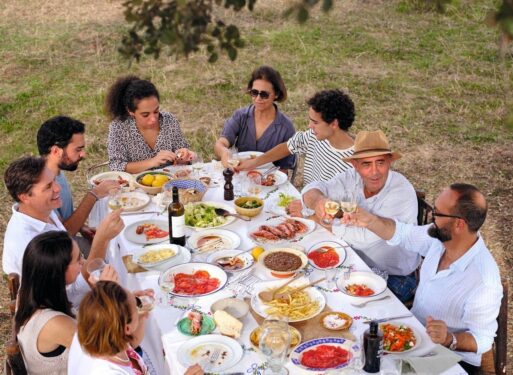
Within the strict formalities of a typical Greek Orthodox funeral, a tradition provides families with the opportunity to unwind. Makaria, an enduring Greek Orthodox funeral tradition, brings families and friends together to celebrate, share stories, and mourn their loved one over plates of traditional Greek cuisine.
The term “Makaria” stems from the Greek word, makarios, meaning blessed, often translated as the “meal of blessings” or “mercy meal.” It also shares a connection with two goddesses in Greek mythology, both associated with honorable or blessed deaths.
The Greek Orthodox tradition of Makaria originated in ancient Greece and transformed as Christianity spread through the empire. Archeologists and historians believe that ancient Greeks used to prepare grand feasts following the burial of a loved one. The deceased was considered to be the “host” of the feast, offering food and drinks to those who helped them make a safe passage to the afterlife. These feasts were bountiful and encouraged heavy eating and drinking as a means of celebrating and honoring their host. Family members of the deceased weren’t the only ones to enjoy in the tradition; food was often shared with the community as an expression of generosity.
As the dominance of Christianity spread, the tradition evolved to become more reserved, with a focus on Jesus and a shift toward asceticism to reflect his humility. The former feasts of indulgence that involved the entire community became more family oriented and religiously centered. Christianity also formalized a set of strict funerary practices across Greece.

The makaria meal can take place in any setting, even outdoors
Credit: boundless.life
In modern-day Greece, where nearly 90% of the population identifies as Greek Orthodox Christians, traditional funerals follow a series of steps with specific guidelines. The funeral process includes a wake, a Trisagion prayer service the night before the funeral, the funeral itself followed by the burial, and finally, the Makaria.
All attendees of the funeral are expected to join the Makaria, viewing it as a continuation of the memorial service where stories are share, and collective mourning takes place. Unlike the formal tone of the previous funerary practices, where participants are not expected to speak unless in reply to the priest, the Makaria is a more casual affair that takes place at the family’s home, the church or a nearby restaurant, providing a space for family members to share eulogies and speak openly with one another.
At a traditional a Makaria, the central entrée is broiled fish, known as “plaki.” Choice fishes for this main dish include cod and sole. For Greek Orthodox Christians, this dish serves as a parallel to Jesus’s first meal after resurrection which he shared with his disciples. In Christian tradition, fish and its association with Jesus’s miracles and his modest living represents the suffering martyrs endured to maintain their faith against prosecution and is therefore seen as a food deeply aligned with Christian values.

Additional side dishes to the standard Makaria include Greek salad, bread, vegetables, tiropita, spanakopita and rice pilaf, accompanied by coffee, congac and Greek brandy called Metaxa. Notably absent are meat and decadent desserts, as they are considered more suitable for celebratory feasts. Families often prepare the meal themselves or cater from a local restaurant, maintaining the traditional items that define the Makaria experience. The immediate family of the deceased eat first while guests wait respectfully for their turn to serve their plates.
Makaria, with its distinctive fusion of ancient Greek and Christian beliefs, offers a reprieve from conventional formalities, creating a space to exchange stories and celebrate life. In the ever-evolving landscape of repast traditions across cultures, the centrality of food remains unwavering—a focal point that brings families together, providing a shared moment for grieving and solace.

 Makaria: A Greek Orthodox Tradition with Ancient Roots
Makaria: A Greek Orthodox Tradition with Ancient Roots


 Recovering Cremation Remains After the Los Angeles Fires
Recovering Cremation Remains After the Los Angeles Fires
 “As Tears Go By” by Marianne Faithfull
“As Tears Go By” by Marianne Faithfull
 “The Sea” by John Banville
“The Sea” by John Banville















